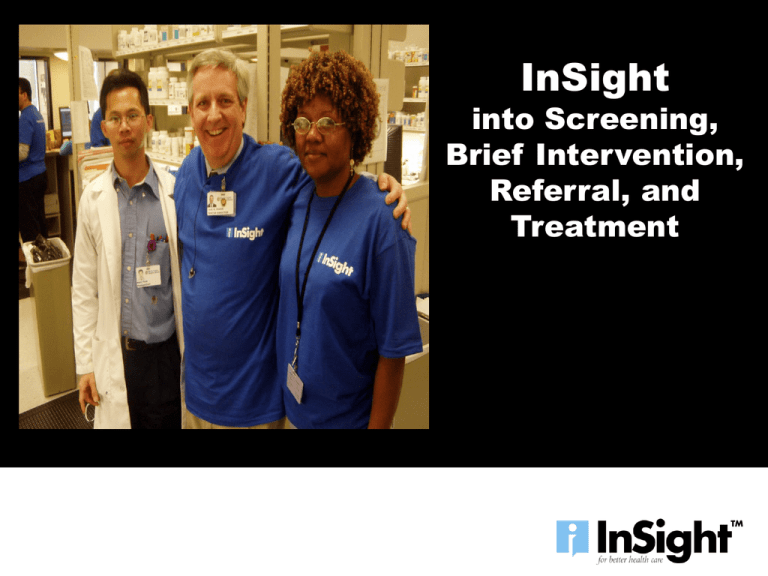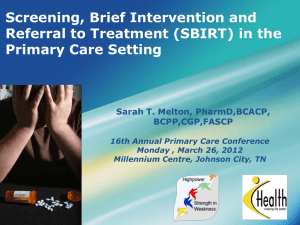InSight into Screening, Brief Intervention, Referral, and
advertisement

InSight into Screening, Brief Intervention, Referral, and Treatment IOM Recommendations Providers • Organizations should (Chapter 4): – Increase use of valid and reliable patient questionnaires – Use measures of process and quality to continuously improve the quality of care they provide What is Screening? Screening is performed using a distinct valid brief questionnaire (AUDIT, DAST, ASSIST) • Method of identifying individuals at-risk. • Determine level of risk. • Provides an opportunity for feedback. What is Brief Intervention? • A 15 to 45 minute facilitated interaction – Express concern – Provide feedback – Explore the issue – Promotes change Brief Intervention Evidence • World Health Organization (Am J Pub Health 1996) Multinational study of heavy drinkers Simple advice, brief & extended counseling compared to control group (N = 1,260) Consumption decreased: 21% with 5 minutes of advice 27% with 15 minutes of advice 7% among controls Efficacy and Cost of Advice At 4 years… Control Intervention Hospital Days (p<0.05) 663 420 ED Visits (p<0.08) 376 302 Risky Drinking* (p<0.001) 35% 23% Cost of intervention: $166 per patient (includes patient costs) Net benefit: $546 in medical costs, $7780 if societal costs included (mainly motor vehicle) *36 months. >20 drinks (men), >13 drinks (women) per week - Fleming MF et al., 2002. Intervention in Trauma Patients • Gentilello et al. (Ann Surg 1999) – Admitted trauma patients 46% screened positive for alcohol problem – 30’ intervention psychologist – Intervention ~50% decrease in trauma and subsequent hospitalization American College of Surgeons Level I Trauma Center Verification process now requires Screening and Brief Intervention Brief Intervention and Drug Use • Meta Analysis of 5 studies – Moderate decrease in drug use – Large effect on social outcomes • Review of 17 trials – 14 of 17 with positive results – Increased treatment involvement – Increased abstinence – Reduced drug-related problems Mesa Grande • 361 controlled studies – evaluated at least one treatment for AUD – compared it with an alternative condition – used a procedure designed to create equivalent groups before treatment – reported at least 1 outcome measure of drinking or alcohol-related consequences Miller, WR Addiction 2002 97(3) Mesa Grande • Methodological quality of studies was significantly but modestly correlated with the reporting of a specific effect of treatment • The strongest evidence of efficacy was found for BI, social skills training, the community reinforcement approach, behavior contracting, behavioral marital therapy and case management • Most strongly supported approaches included: opiate antagonists (naltrexone, nalmefene) and acamprosate • Least supported were methods designed to educate, confront, shock or foster insight regarding the nature and causes of alcoholism Miller, WR Addiction 2002 97(3) Brief motivational feedback better than InternetBarnett et al. 2004 based educational intervention to motivate Trends in SBI: Lessons from the Field students enter counseling Borsari and Carey 2005 Brief individual motivational sessions reduced consumption more at 3 months and 6 months than did standard alcohol education Small-group feedback sessions were effective McNally and Palfai at reducing alcohol use among heavy-drinking 2003 students at 4-week follow-ups. Reductions in drinking with mailed motivational Murphy et al. 2004 feedback and in-person feedback interviews Neighbors et al. 2004a Reduced use at 3- and 6-month follow-ups with computerized feedback compared with an assessment-only control group White et al., 2006 Students in brief motivational interview (BMI) intervention and a written feedback-only (WF) intervention reduced alcohol, cigarette and marijuana use, and problems related to use Brief Review of the Evidence Screening can identify people drinking risky amounts, problems or alcohol use disorders Screening followed by a brief (nonjudgmental) intervention can result in reduced drinking Evidence varies by setting For drug use and related problems/disorders evidence for efficacy is more limited For adolescents there is limited data Request For Applications – SAMHSA/CSAT • Expand the State’s continuum of care to include screening, brief intervention, referral, and brief treatment (SBIRT) in general medical and other community settings • Identify systems and policy changes to increase access to treatment in generalist and specialist settings SBIRT GPRA SUMMARY* AREA TARGET TO DATE ACTUAL TO DATE PERCENTAGE SCREENING 171,876 305898 178% BRIEF INTERVENTION 42,926 56,432 131% BRIEF TREATMENT 6,604 9,443 143% REFERRAL TO TREATMENT 6,094 10,883 178% *SBIRT GPRA Summary as of 5/15/06 Anecdotal Observations • Adoption slow • Time considerations with resistant versus receptive patients • System-wide approaches – eligibility criteria? • Little consensus on favorable outcome Future Directions - Research • Outcomes & costs for system-wide SBI • Public versus Private • When treatment of dependence included • Line item versus billable service • • • • Long-term effectiveness Dosing (number and length of sessions) Differences adults and adolescents Multiple lifestyle interventions


